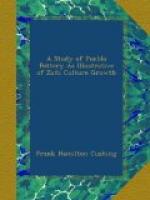[2] I would refer those, who may wish to find this characteristic more fully set forth, to the introductory pages of my essay on Zuni Fetiches, published in the second volume of Contributions to North American Ethnology by the Bureau of Ethnology; also to a paper read before the American Academy of Sciences on the Relations to one another of the Zuni Mythologic and Sociologic Systems, published, I regret to say, without my revision, in the Popular Science Monthly, for July, 1882.
I here allude to this mental bias because it has both influenced the decoration of pottery and has been itself influenced by it. In the first place, the noise made by a pot when struck or when simmering on the fire is supposed to be the voice of its associated being. The clang of a pot when it breaks or suddenly cracks in burning is the cry of this being as it escapes or separates from the vessel. That it has departed is argued from the fact that the vase when cracked or fragmentary never resounds as it did when whole. This vague existence never cries out violently unprovoked; but it is supposed to acquire the power of doing so by imitation; hence, no one sings, whistles, or makes other strange or musical sounds resembling those of earthenware under the circumstances above described during the smoothing, polishing, painting, or other processes of finishing. The being thus incited, they think, would surely strive to come out, and would break the vessel in so doing. In this we find a partial explanation of the native belief that a pot is accompanied by a conscious existence. The rest of the solution of this problem in belief is involved in the native philosophy and worship of water. Water contains the source of continued life. The vessel holds the water; the source of life accompanies the water, hence its dwelling place is in the vessel with the water. Finally, the vessel is supposed to contain the treasured source, irrespective of the water—as do wells and springs, or even the places where they have been. If the encircling lines inside of the eating bowl, outside of the water jar, were closed, there would be no exit trail for this invisible source of life or for its influence or breath. Yet, why, it maybe asked, must the source of life or its influence be provided with a trail by which to pass out from the vessel? In reply to this I will submit two considerations. It has been stated that on the earliest Southwestern potteries decoration was effected by incised or raised ornamentation. Any one who has often attempted to make vessels according to primitive methods as I have has found how difficult it is to smoothly join a line incised around a still soft clay pot, and that this difficulty is even greater when the ornamental band is laid on in relief. It would be a natural outgrowth of this predicament to leave the ends unjoined, which indeed the savage often did. When paint instead of incision or relief came to be the decorative




